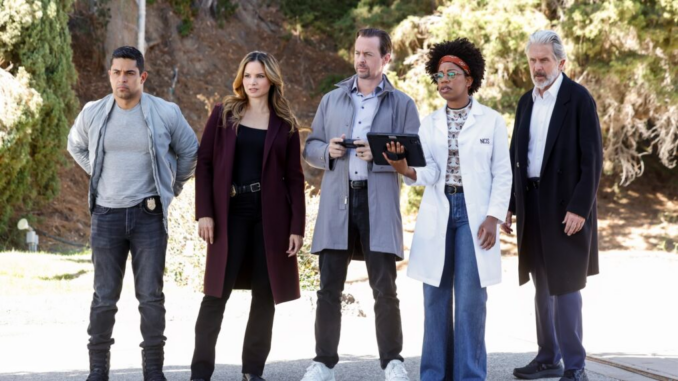
If you’re a fan of NCIS, you probably think of navy investigations, Gibbs’ rules, and high-tech crime-solving. But what if we told you that none of it might exist without… The West Wing?
Yes — The West Wing, the political drama with fast-talking presidential aides and moral debates in the Oval Office. On the surface, these two shows couldn’t be more different. But behind the scenes? One helped pave the way for the other.
Let’s explore how The West Wing was the domino that led to the creation of one of the most beloved TV crime franchises of all time.
A Political Powerhouse That Changed Network TV
When The West Wing premiered in 1999, it wasn’t just another political drama — it was a game-changer.
Created by Aaron Sorkin, it delivered sharp dialogue, ethical gray areas, and idealistic storytelling. More importantly, it proved something big to the TV industry:
Audiences were hungry for smart, government-focused dramas.
That success cracked open the door for creators with federal, military, or procedural stories to tell — including Donald P. Bellisario, who had an idea for a Navy-focused investigative team.
Enter JAG — And the Backdoor Pilot That Birthed NCIS
Here’s where things start to connect.
Before NCIS existed, JAG (Judge Advocate General) was CBS’s military legal drama, created by Bellisario. Thanks to The West Wing’s momentum, there was suddenly a bigger appetite for shows centered around Washington, government systems, and national security.
And in Season 8 of JAG, Bellisario introduced a few new characters in a two-part episode — including a gruff, no-nonsense agent named Leroy Jethro Gibbs.
That two-parter was a backdoor pilot for NCIS.
So if The West Wing hadn’t raised the profile of government-centric dramas? JAG might never have had the support to spin off into NCIS.
The West Wing’s Influence on NCIS’s Style
Sure, NCIS is flashier and more action-packed. But you can feel the tonal echoes of The West Wing all over it — just dressed up in navy blue.
Fast-Paced Dialogue and Snappy Banter
Remember those iconic “walk-and-talk” scenes from The West Wing? NCIS doesn’t literally copy them, but the quick back-and-forths between team members, especially in the bullpen, definitely carry that same energy.
Whether it’s DiNozzo cracking jokes, Abby getting excited about evidence, or McGee geeking out about tech — it all reflects the ensemble chemistry The West Wing perfected.
Shared Themes: Integrity, Loyalty, and Mission-Driven Characters
While one show is about politicians and the other is about federal agents, both share a core message: doing the right thing, even when it’s hard.
-
President Bartlet and his team agonized over ethical choices daily.
-
Gibbs lives by a personal code (literally — Gibbs’ Rules), and his team often faces dilemmas that challenge their morals.
That emphasis on principled decision-making is no coincidence.
Shared DNA in Casting and Creative Minds
Let’s not forget the people behind the curtain. TV is a small world, and many of the creatives behind NCIS had deep ties to shows influenced by or directly connected to The West Wing.
Actors like Mark Harmon (Gibbs) were already seasoned pros in politically charged roles before joining NCIS. In fact, Harmon played a Secret Service agent on The West Wing, and that role helped boost his profile again before he became Gibbs.
CBS’s Strategic Vision Was Shaped by West Wing’s Success
The West Wing’s success made networks like CBS realize something: intelligent, government-adjacent shows could thrive, even in prime time.
That confidence encouraged CBS to:
-
Keep investing in JAG
-
Greenlight NCIS
-
Eventually launch an entire NCIS franchise with spinoffs like Los Angeles, New Orleans, Hawai‘i, and Sydney
So yes — The West Wing didn’t just help NCIS exist. It helped it become a phenomenon.
Different Worlds, Shared Legacy
One show took place in the White House. The other, in Navy yards and crime scenes. But The West Wing and NCIS are both products of an era that trusted viewers to follow complex, character-driven stories.
They’re proof that good storytelling — with layered characters and real stakes — always finds an audience.
Conclusion: From the Oval Office to NCIS Headquarters
It might sound strange at first, but The West Wing and NCIS are more connected than fans realize. One opened the door for government-centered drama to dominate prime time. The other walked through that door with a Caf-Pow in hand and a badge on its belt.
So next time you watch Gibbs interrogate a suspect or watch the team piece together a naval crime, just remember — somewhere in the background, there’s a bit of West Wing DNA helping make it all work.
FAQs
Q1: Was Mark Harmon really on The West Wing?
A: Yes! He played Secret Service agent Simon Donovan in a short but memorable arc. It helped reignite his mainstream popularity before NCIS.
Q2: Did NCIS really spin off from JAG?
A: Absolutely. NCIS debuted as a backdoor pilot in JAG Season 8 and became its own series in 2003.
Q3: How are The West Wing and NCIS similar in tone?
A: Both focus on teamwork, ethical dilemmas, and characters navigating complex government systems.
Q4: Are there shared writers or producers between the shows?
A: While not directly, many writers and producers who worked on NCIS had experience on politically themed or government-adjacent shows influenced by The West Wing.
Q5: Would NCIS have been made without The West Wing’s success?
A: Possibly — but The West Wing definitely helped prove the audience was ready for more serious, smart storytelling in a federal setting.
